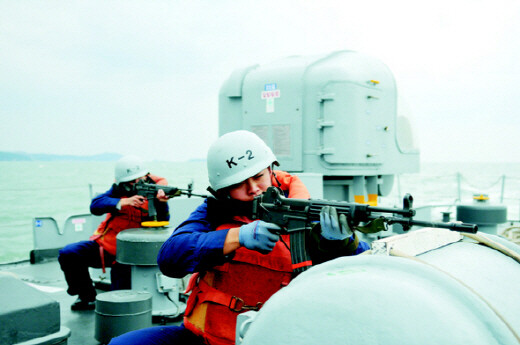hankyoreh
Links to other country sites 다른 나라 사이트 링크
Military prepares for exercises near N.Korean border

By Son Won-je, Staff Writer
The military plans to hold a large-scale response exercises Wednesday according to the scenario of a North Korean surprise assault on the Northwest Islands and military provocation. This comes one year to the day after the artillery attack on Yeonpyeong Island.
In particular, exercises equivalent to a regional warfare scenario are being held under the command of the Chairman of the Joint Chiefs of Staff, going beyond an early-stage strike on the origin of the North Korean provocation and assaulting the North Korean military command post with state-of-the-art army, navy, and air force weaponry.
The first component is an exercise for a hypothetical artillery attack by the Marine unit on Yeonpyeong Island. At 1 p.m., a mock marine firing exercise is being held with crew-served weapons such as the K9 self-propelled artillery. A hypothetical North Korean response with a launch of dozens of rounds of 122 mm artillery at the Gaemeori area 12 kilometers off Yeonpyeong Island is planned for 2:33 p.m. The unit is to inflict a massive counterattack on the source of the provocation with K9 artillery, which is on standby according to a policy of “action first, reporting later.” The source is detected with an Artillery Hunting Radar (ARTHUR) system that was newly positioned in the wake of last year’s shelling.
A Joint Chiefs of Staff official said, “Last year, we fired artillery toward a pre-designated target because we were unable to immediately locate the origin of the provocation, but our exercises this time are based on a scenario where the origin is precisely detected and fired upon.”
The military’s response goes beyond this. Joint Chiefs of Staff Chairman Jung Seung-jo is to issue an emergency standby order to the six operational commands: Air Force Operations Command, Naval Operations Command, Marine Corps Headquarters, 1st and 3rd Army Commands, and Guided Missile Command. An attack order is then transmitted to KF-16 and F-15 fighter aircraft. The 4,500-ton Korean Destroyer, which is carrying out operations at sea, assumes a combat readiness posture and prepares to launch guided missiles and naval artillery. The army goes on alert in preparation for additional provocations and a surprise infiltration from the enemy side.
A scenario is assumed in which the North Korean military launches a second artillery attack with its Mudo Island naval artillery after suffering heavy losses at the origin of its original attack from Yeonpyeong unit artillery. Jung issues an order for a concerted counterattack from the Army, Navy, and Air Force, which are on standby. The KF-16 fighters use air-to-surface surgical strike missiles to destroy the Mudo base from which the second provocation is launched. The F-15K fighters send AGM-84H precision guided missiles toward the North Korean command post and support facilities. These missiles are capable of a surgical strike on targets in Pyongyang from south of the Northern Limit Line.
Next, defensive exercises are held in preparation for an attempted surprise occupation of Baengnyeong Island by the marine sniper brigades, North Korea’s special forces. This involves using the Army’s Cobra attack helicopters and Navy and Air Force power to fire upon a North Korean hovercraft advancing on the island.
The exercises involve the use of fighter aircraft and naval vessels, but no actual firing takes place.
A Joint Chiefs of Staff official said, “We do not intend to allow the North Korean military to use our exercises as an excuse for a provocation in response.”
Seoul National University Institute for Peace and Unification Studies senior researcher Jang Yong-seok expressed concerns that the response with a strike on the North Korean command post could increase the chances of escalation as North Korean responds.
“We need to go beyond exercises for military readiness and also make active dialogue efforts to resolve the military tensions,” Jang said.
Please direct questions or comments to [englishhani@hani.co.kr]
Editorial・opinion
![[Column] Park Geun-hye déjà vu in Yoon Suk-yeol [Column] Park Geun-hye déjà vu in Yoon Suk-yeol](https://flexible.img.hani.co.kr/flexible/normal/500/300/imgdb/original/2024/0424/651713945113788.jpg) [Column] Park Geun-hye déjà vu in Yoon Suk-yeol
[Column] Park Geun-hye déjà vu in Yoon Suk-yeol![[Editorial] New weight of N. Korea’s nuclear threats makes dialogue all the more urgent [Editorial] New weight of N. Korea’s nuclear threats makes dialogue all the more urgent](https://flexible.img.hani.co.kr/flexible/normal/500/300/imgdb/original/2024/0424/7317139454662664.jpg) [Editorial] New weight of N. Korea’s nuclear threats makes dialogue all the more urgent
[Editorial] New weight of N. Korea’s nuclear threats makes dialogue all the more urgent- [Guest essay] The real reason Korea’s new right wants to dub Rhee a founding father
- [Column] ‘Choson’: Is it time we start referring to N. Korea in its own terms?
- [Editorial] Japan’s rewriting of history with Korea has gone too far
- [Column] The president’s questionable capacity for dialogue
- [Column] Are chaebol firms just pizza pies for families to divvy up as they please?
- [Column] Has Korea, too, crossed the Rubicon on China?
- [Correspondent’s column] In Japan’s alliance with US, echoes of its past alliances with UK
- [Editorial] Does Yoon think the Korean public is wrong?
Most viewed articles
- 1‘We must say no’: Seoul defense chief on Korean, USFK involvement in hypothetical Taiwan crisis
- 2N. Korean delegation’s trip to Iran shows how Pyongyang is leveraging ties with Moscow
- 3Amnesty notes ‘erosion’ of freedom of expression in Korea in annual human rights report
- 4[Column] Park Geun-hye déjà vu in Yoon Suk-yeol
- 5‘Weddingflation’ breaks the bank for Korean couples-to-be
- 6[Reportage] On US campuses, student risk arrest as they call for divestment from Israel
- 7[Editorial] New weight of N. Korea’s nuclear threats makes dialogue all the more urgent
- 8Korea sees more deaths than births for 52nd consecutive month in February
- 9Will NewJeans end up collateral damage in internal feud at K-pop juggernaut Hybe?
- 10Why Korea shouldn’t welcome Japan’s newly beefed up defense cooperation with US